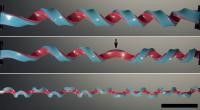Scientists Discover New Rare 'Hemihelix' Shape Using Rubber Bands

Scientists have stumbled upon a new shape called a hemihelix, which is rarely seen in nature.
While studying new springs to support a cephalopod-inspired imaging project, researchers from Harvard University discovered a new shape which could spur the creation of new molecules.
Knowing how to make the structures may enable scientists to mimic the geometrical features in new molecules that could lead to possible advances in modern nanodevices, including sensors, resonators, and electromagnetic wave absorbers.
"Once you are able to fabricate these complex shapes and control them, the next step will be to see if they have unusual properties; for example, to look at their effect on the propagation of light," says Katia Bertoldi, an associate professor in applied mechanics at Harvard.

The hemihelix, the shape that Bertoldi and her colleagues encountered, has multiple "perversions".
Helices are three-dimensional structures, such as a corkscrew or a slinky toy. Hemihelices form when the direction in which the spiral turns—known as the chirality—changes periodically along the length. The reversal in chirality is called a perversion.
David Clarke, a professor of materials at the university, explained that the team was trying to make two-dimensional springs when they made the discovery. They were taking two strips of rubber material of different lengths, stretching the shorter one to reach the same length as the longer one and sticking the pieces together.
"We expected that these strips of material would just bend—maybe into a scroll," he said. "But what we discovered is that when we did that experiment we got a hemihelix and that it has a chirality that changes, constantly alternating from one side to another."
One member of the team tested differences in the aspect ratio—the width-to-height ratio of the rubber strips—and discovered that when a strip is very wide relative to its height, it produces a helix.
Further measurements revealed that there is a critical value of the aspect ratio at which the resulting shape transitions from a helix to a hemihelix with periodic reversals of chirality.
Other classes of materials would simply break when stretched to the mismatched strains that the polymers endured—likely the reason this behaviour had never been observed before.
"We see deterministic growth from a two-dimensional state—two strips bonded together—to a three-dimensional state," Jia Liu, a graduate researcher, said. "The actual number of perversions, the diameter, everything else about it is entirely prescribed. There is no randomness; it's fully deterministic. So if you make one hundred of these, they'll always perform exactly the same way."
Bertoldi added: "From a mechanical point of view you can look at these as different springs with very different behaviour. Some of them are very soft and then they stiffen up. Some are more linear. Simply by changing geometry, you can design this whole family of springs with very different behaviour with predictable results."
The researchers believe that their findings provide important clues for how to fabricate a variety of three-dimensional shapes from flat parts.
"Intellectually, it's interesting—and we believe it is significant too," Clarke explained. "There are a variety of complex shapes in nature that arise as a result of different growth rates. We stumbled quite by accident on a way to achieve fully deterministic manufacture of some three-dimensional objects."
The results were published in PLOS One.
© Copyright IBTimes 2025. All rights reserved.






















